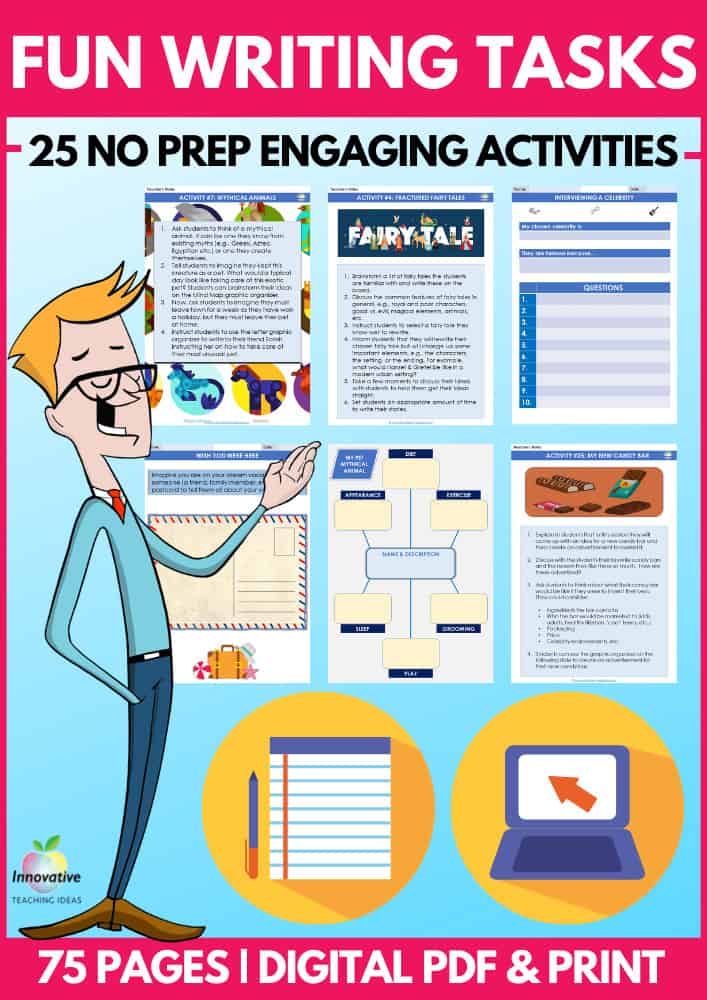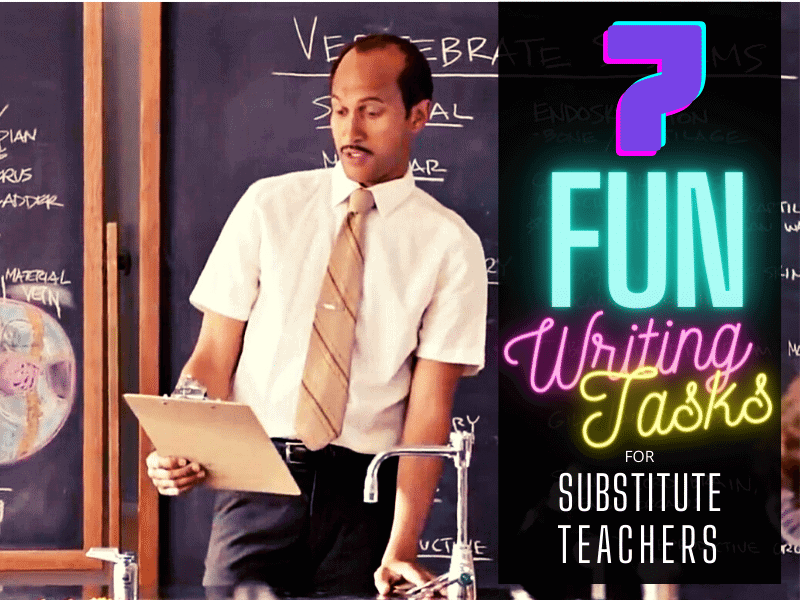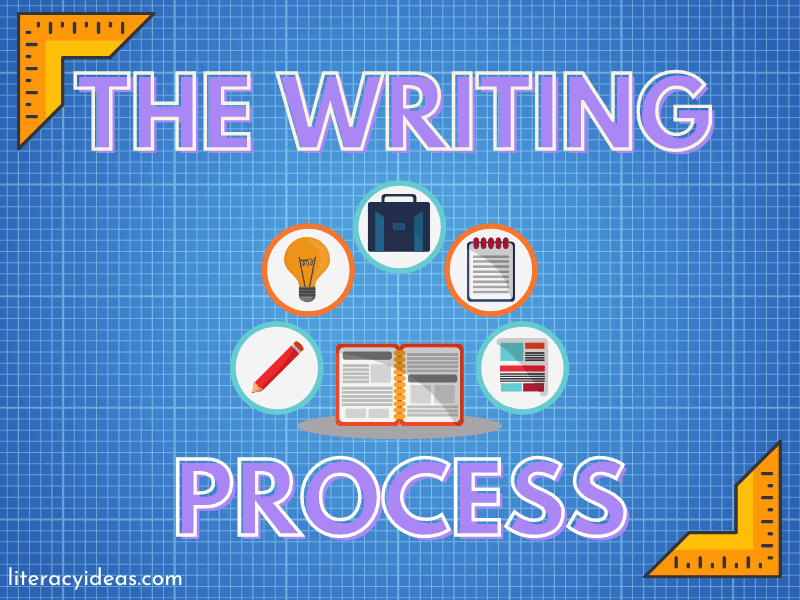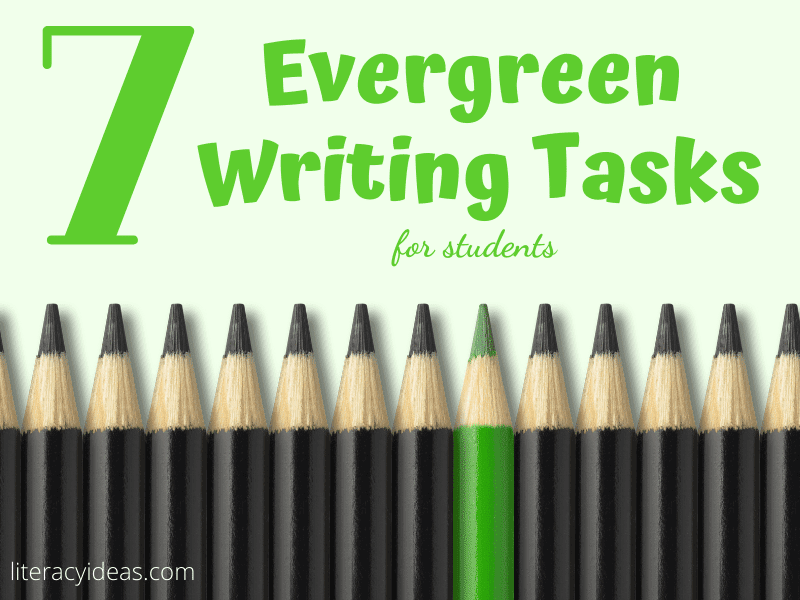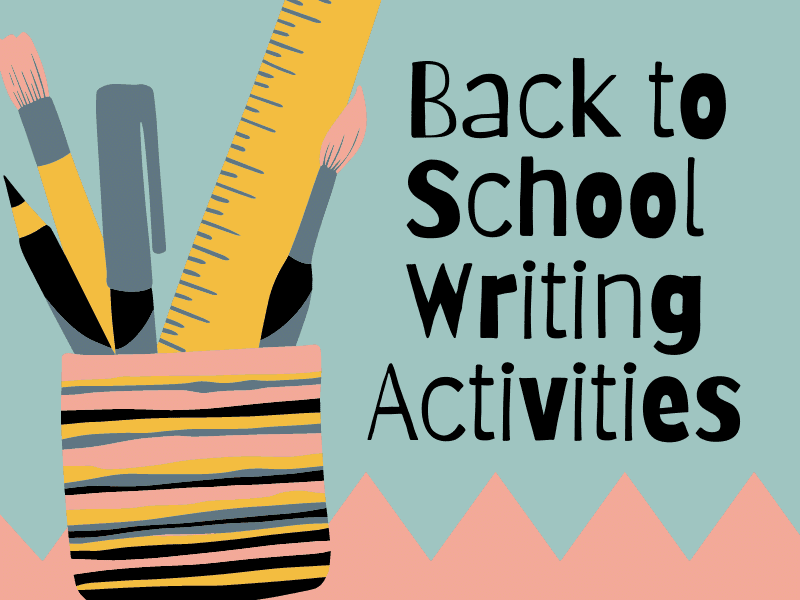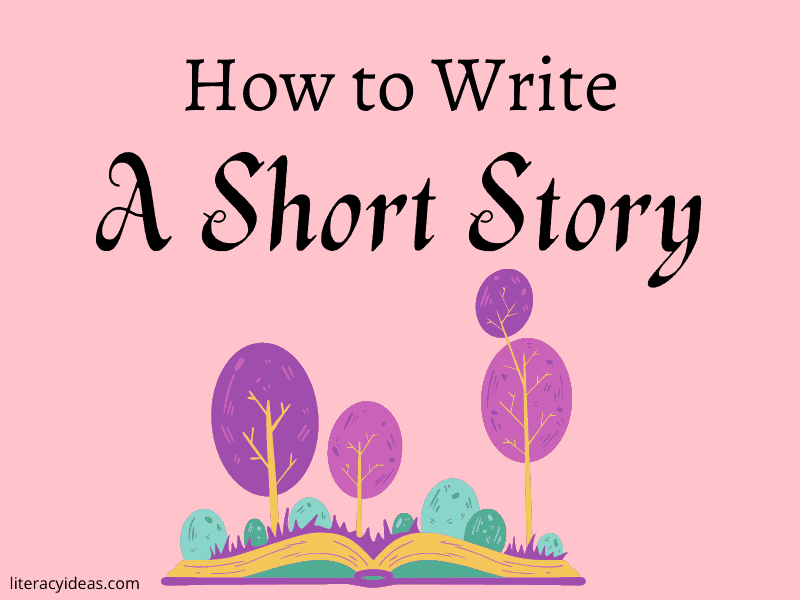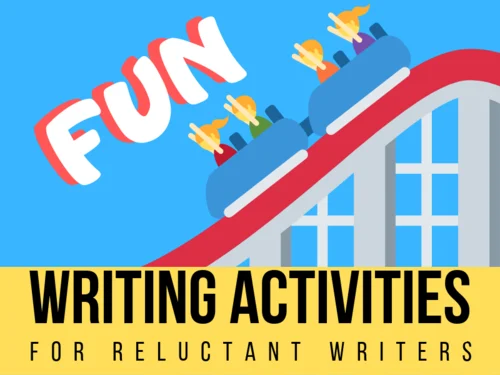
10 FUN WRITING ACTIVITIES FOR THE RELUCTANT WRITER
No doubt about it – writing isn’t easy. It is no wonder that many of our students could be described as ‘reluctant writers’ at best. It has been estimated by the National Association of Educational Progress that only about 27% of 8th and 12th-grade students can write proficiently.
As educators, we know that regular practice would go a long way to helping our students correct this underachievement, and sometimes, writing prompts just aren’t enough to light the fire.
But how do we get students, who have long since been turned off writing, to put pen to paper and log the requisite time to develop their writing chops?
The answer is to make writing fun! In this article, we will look at some creative writing activities where we can inject a little enjoyment into the writing game.
1. Poetry Scavenger Hunt
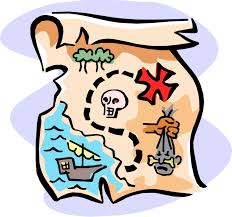
The Purpose: This activity encourages students to see the poetry in the everyday language around them while helpfully reinforcing their understanding of some of the conventions of the genre.
The Process: Encourage students to ‘scavenge’ their school, home, and outside the community for snippets of language they can compile into a piece of poetry or a poetic collage. They may copy down or photograph words, phrases, and sentences from signs, magazines, leaflets or even snippets of conversations they overhear while out and about.
Examples of language they collect may range from the Keep Out sign on private property to the destination on the front of a local bus.
Once students have gathered their language together, they can work to build a poem out of the scraps, usually choosing a central theme to give the piece cohesion. They can even include corresponding artwork to enhance the visual appeal of their work, too, if they wish.
The Prize: If poetry serves one purpose, it is to encourage us to look at the world anew with the fresh eyes of a young child. This activity challenges our students to read new meanings into familiar things and put their own spin on the language they encounter in the world around them, reinforcing the student’s grasp on poetic conventions.
2. Story Chains

The Purpose: Writing is often thought of as a solitary pursuit. For this reason alone, it can be seen as a particularly unattractive activity by many of our more gregarious students. This fun activity exercises students’ understanding of writing structures and engages them in fun, creative collaboration.
The Process: Each student starts with a blank paper and pen. The teacher writes a story prompt on the whiteboard. You’ll find some excellent narrative writing prompts here. For example, each student spends two minutes using the writing prompt to kick-start their writing.
When they have completed this part of the task, they will then pass their piece of paper to the student next to them. Students then continue the story from where the previous student left off for a given number of words, paragraphs, or length of time.
If organized correctly, you can ensure students receive their own initial story back at the end for the writing of the story’s conclusion.
The Prize: This fun writing activity can be used effectively to reinforce student understanding of narrative writing structures, but it can also be fun to try with other writing genres.
Working collaboratively motivates students to engage with the task, as no one wants to be the ‘weak link’ in the finished piece. But, more than that, this activity encourages students to see writing as a communicative and creative task where there needn’t be a ‘right’ answer. This encourages students to be more willing to take creative risks in their work.
3. Acrostic Associations
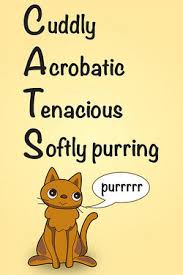
The Purpose: This is another great way to get students to try writing poetry – a genre that many students find the most daunting.
The Process: Acrostics are simple poems whereby each letter of a word or phrase begins a new line in the poem. Younger students can start off with something very simple, like their own name or their favorite pet and write this vertically down the page.
Older students can take a word or phrase related to a topic they have been working on or have a particular interest in and write it down on the page before beginning to write.
The Prize: This activity has much in common with the old psychiatrist’s word association technique. Students should be encouraged to riff on ideas and themes generated by the focus word or phrase. They needn’t worry about rhyme and meter and such here, but the preset letter for each line will give them some structure to their meanderings and require them to impose some discipline on their wordsmithery, albeit in a fun and loose manner.
4. The What If Challenge

The Purpose: This challenge helps encourage students to see the link between posing interesting hypothetical questions and creating an entertaining piece of writing.
The Process: To begin this exercise, have the students come up with a single What If question, which they can then write down on a piece of paper. The more off-the-wall, the better!
For example, ‘What if everyone in the world knew what you were thinking?’ or ‘What if your pet dog could talk?’ Students fold up their questions and drop them into a hat. Each student picks one out of the hat before writing on that question for a suitable set amount of time.
Example What If Questions
- “What if you woke up one day and found out that you had the power to time travel?”
- “What if you were the last person on Earth? How would you spend your time?”
- “What if you were granted three wishes, but each one came with a terrible consequence?”
- “What if you discovered a secret portal to another world? Where would you go, and what would you do?”
- “What if you woke up one day with the ability to communicate with animals? How would your life change?”
The Prize: Students are most likely to face the terror of the dreaded Writer’s Block when they are faced with open-ended creative writing tasks.
This activity encourages the students to see the usefulness of posing hypothetical What If questions, even random off-the-wall ones, for kick-starting their writing motors.
Though students begin by answering the questions set for them by others, please encourage them to see how they can set these questions for themselves the next time they suffer from a stalled writing engine.
5. The Most Disgusting Sandwich in the World

The Purpose: Up until now, we have looked at activities encouraging our students to have fun with genres such as fiction and poetry. These genres being imaginative in nature, more easily lend themselves to being enjoyable than some of the nonfiction genres.
But what about descriptive writing activities? In this activity, we endeavor to bring that same level of enjoyment to instruction writing while also cleverly reinforcing the criteria of this genre.
The Process: Undoubtedly, when teaching instruction writing, you will at some point cover the specific criteria of the genre with your students.
These will include things like the use of a title, numbered or bulleted points, time connectives, imperatives, diagrams with captions etc. You will then want the students to produce their own piece of instruction writing or procedural text to display their understanding of how the genre works.
But, why not try a fun topic such as How to Make the Most Disgusting Sandwich in the World rather than more obvious (and drier!) topics such as How to Tie Your Shoelaces or How to Make a Paper Airplane when choosing a topic for your students to practice their instruction writing chops?
Example of a Most Disgusting Sandwich Text
Ingredients: Two slices of moldy bread A generous spread of chunky peanut butter mixed with expired mayonnaise A layer of overripe bananas that have been sitting in the sun for a day A handful of crushed potato chips that have been left out for days and are now stale A dollop of blue cheese mixed with tuna that has been sitting in a can for weeks A few slices of raw onion that has been soaked in vinegar for hours A sprinkle of sugar-coated bacon bits that have been cooked until crispy, then left out to cool for hours Instructions: Take two slices of moldy bread and spread a generous amount of the peanut butter and expired mayonnaise mixture on each slice. Layer the overripe bananas on one slice of the bread, then sprinkle the crushed potato chips on top. In a small bowl, mix together the blue cheese and tuna until it becomes a chunky paste. Spread this mixture on top of the bananas and potato chips. Add a few slices of raw onion that have been soaked in vinegar on top of the tuna mixture. Finally, sprinkle the sugar-coated bacon bits on top of the onions, and top with the other slice of bread. And there you have it, a disgustingly creative sandwich recipe that will make your stomach turn!
The Prize: As mentioned, with nonfiction genres, in particular, we tend to suggest more banal topics for our students to work on while internalizing the genre’s criteria. Enjoyment and acquiring practical writing skills need not be mutually exclusive.
Our students can just as quickly, if not more easily, absorb and internalize the necessary writing conventions while engaged in writing about whimsical and even nonsensical topics.
if your sandwich is entering the realm of horror, be sure to check our complete guide to writing a scary story here as well.
6. Diary Entry of a Future Self

The Purpose: This activity allows students to practice personal writing within diary/journal writing conventions. It also challenges them to consider what their world will be like in the future, perhaps stepping a foot into the realm of science fiction.
The Process: Straightforwardly, after working through some examples of diary or journal writing, and reviewing the various criteria of the genre, challenge the students to write an entry at a given milestone in the future.
This may be when they leave school, begin work, go to university, get married, have kids, retire, etc. You may even wish to get the students to write an entry for a series of future milestones as part of a more extended project.
Example of Message to Future Me Text
Dear Future Me, Hi! It's me, your 12-year-old self, writing to you from the past. I hope this letter finds you well, and that you're still as in love with horses as I am right now. I just wanted to take a few minutes to write down some of my thoughts and feelings about these amazing creatures, and to remind you of how much they mean to us. Today was a beautiful day, and I spent most of it at the stables with my favorite horse, Misty. She's a beautiful brown mare with a gentle personality, and spending time with her always makes me feel happy and peaceful. We went on a long trail ride through the woods, and I could feel the wind in my hair and the sun on my face as we galloped along. It was one of those moments when everything just feels right in the world, you know? I hope that you're still riding and caring for horses, and that you've had many more wonderful experiences like the one I had today. I hope that you've made some lifelong friends at the stables, and that you've learned even more about these incredible animals than I have. And most of all, I hope that you're still filled with the same joy and wonder that I feel whenever I'm around horses. I know that life can be busy and stressful, and that you might not have as much time for horses as you used to. But please, don't ever forget how much they mean to you, and how much they've helped you grow and learn over the years. Keep riding, keep exploring, and keep living your life to the fullest. Love, Your 12-year-old self
The Prize: Students will get a chance here to exercise their understanding of this type of writing, but more than that, they will also get an opportunity to exercise their imaginative muscles too. They will get to consider what shape their future world will take in this engaging thought experiment that will allow them to improve their writing too.
7. Comic Strip Script
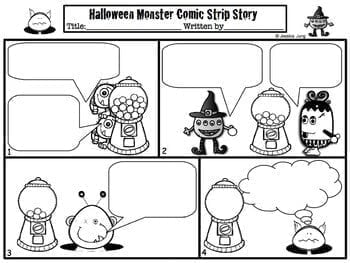
The Purpose: Give your students the chance to improve their dialogue writing skills and work on their understanding of character development in this fun activity which combines writing with a series of visual elements.
The Process: There are two ways to do this activity. The first requires you to source or create a comic strip without the dialogue the characters are speaking. This may be as straightforward as using whiteout to erase the words in speech bubbles and making copies for your students to complete.
Alternatively, provide the students with photographs/pictures and strips of cards to form their action sequences. When students have their ‘mute’ strips, they can begin to write the dialogue/script to link the panels together.
The Prize: When it comes to writing, comic strips are probably one of the easier sells to reluctant students! This activity also allows students to write for speech. This will stand to them later when they come to produce sections of dialogue in their narrative writing or when producing play or film scripts.
They will also develop their visual literacy skills as they scan the pictures for clues of tone and context before they begin their writing.
Keep It Fun
Just as we should encourage our students to read for fun and wider educational benefits, we should also work to instil similar attitudes towards writing. To do this means we must work to avoid always framing writing in the context of a chore, that bitter pill that must be swallowed for the good of our health.
There is no getting away from the fact that writing can, at times, be laborious. It is time-consuming and, for most of us, difficult at the best of times. There is a certain, inescapable amount of work involved in becoming a competent writer.
That said, as we have seen in the activities above, with a bit of creative thought, we can inject fun into even the most practical of writing activities. All that is required is a dash of imagination and a sprinkling of effort.
8. Character Interviews

The Purpose: Character interviews as writing activities are excellent for students because they encourage creative thinking, character development, and empathy. The purpose of this activity is to help students delve deeper into the minds of the characters they are creating in their stories or reading about in literature. By conducting interviews with these characters, students gain a better understanding of their personalities, motivations, and perspectives.
The Process of character interviews involves students imagining themselves as interviewers and their characters as interviewees. They can either write out the questions and answers in a script-like format or write a narrative where the character responds to the questions in their own voice.
The Prize: Through character interviews, students learn several valuable skills:
- Character Development: By exploring various aspects of their characters’ lives, backgrounds, and experiences, students can develop more well-rounded and authentic characters in their stories. This helps make their fictional creations more relatable and engaging to readers.
- Empathy and Perspective: Conducting interviews requires students to put themselves in their characters’ shoes, considering their thoughts, emotions, and struggles. This cultivates empathy and a deeper understanding of human behavior, which can be applied to real-life situations as well.
- Voice and Dialogue: In crafting the character’s responses, students practice writing authentic dialogue and giving their characters unique voices. This skill is valuable for creating dynamic and believable interactions between characters in their stories.
- Creative Expression: Character interviews provide a creative outlet for students to let their imaginations run wild. They can explore scenarios that may not appear in the main story and discover new aspects of their characters they might not have considered before.
- Critical Thinking: Formulating questions for the interview requires students to think critically about their characters’ personalities and backgrounds. This exercise enhances their analytical skills and storytelling abilities.
Overall, character interviews are a dynamic and enjoyable way for students to delve deeper into the worlds they create or the literature they read. It nurtures creativity, empathy, and writing skills, empowering students to become more proficient and imaginative writers.
Example of a character Interview Interviewer: Ladies and gentlemen, witches and wizards, today we have the honor of sitting down with none other than the legendary Harry Potter himself! Thank you for joining us, Harry. Harry: It's my pleasure. Thanks for having me. Interviewer: You're famous for defeating the Dark Lord Voldemort. Can you tell us how you summoned the courage to face such a powerful adversary? Harry: Well, it wasn't easy. I had amazing friends who supported me throughout, like Hermione and Ron. They believed in me, and that gave me the strength to keep going. Plus, I had to do it to protect the people I cared about and everyone at Hogwarts. It wasn't just about defeating Voldemort; it was about standing up for what's right. Interviewer: Your friendship with Hermione and Ron is truly inspiring. Speaking of friends, how did you feel when you first met Hagrid, and how has he impacted your life? Harry: Meeting Hagrid was one of the most magical moments of my life. He's been like a family to me, especially after I lost my parents. He introduced me to the wizarding world and Hogwarts, and I'll always be grateful for that. Hagrid's taught me about loyalty, kindness, and the importance of standing up for my friends. Interviewer: Hagrid is undoubtedly a remarkable character. Now, let's talk about your time at Hogwarts. Which Hogwarts subject do you enjoy the most, and why? Harry: Definitely Defense Against the Dark Arts. It was always exciting to learn how to defend ourselves against all sorts of magical creatures and dark spells. Plus, Professor Lupin was a fantastic teacher, and he understood what it's like to face fears. It was the one class where I felt like I could truly excel. Interviewer: It's evident that Professor Lupin left a lasting impression on you. Finally, what's your favorite magical creature, and have you had any memorable encounters with them? Harry: My favorite magical creature is definitely the Hippogriff. I had a nerve-wracking but unforgettable experience with Buckbeak. It was during Hagrid's Care of Magical Creatures class when I got to fly on Buckbeak's back. It was exhilarating, and it's something I'll cherish forever. Interviewer: Flying on a Hippogriff sounds incredible! Harry, thank you for sharing your extraordinary journey with us. Your bravery and resilience continue to inspire us all. Harry: Thank you for having me. It's been a pleasure reminiscing about my time at Hogwarts. Always remember, it's our choices that show what we truly are, far more than our abilities.
9. The Travel Journal

The Purpose: Travel journal writing tasks are excellent for students as they offer a unique and immersive way to foster creativity, cultural awareness, and descriptive writing skills. The purpose of this activity is to allow students to embark on a fictional or real travel adventure, exploring new places, cultures, and experiences through the eyes of a traveller.
The process of a travel journal writing task involves students assuming the role of a traveler and writing about their journey in a journal format. They can describe the sights, sounds, tastes, and emotions they encounter during their travels. This activity encourages students to use vivid language, sensory details, and expressive writing to bring their travel experiences to life.
The Prize: Through travel journal writing tasks, students will learn several valuable skills:
- Descriptive Writing: By describing their surroundings and experiences in detail, students enhance their descriptive writing skills, creating engaging and vivid narratives.
- Cultural Awareness: Travel journals encourage students to explore different cultures, customs, and traditions. This helps broaden their understanding and appreciation of diversity.
- Empathy and Perspective: Through writing from the perspective of a traveler, students develop empathy and gain insight into the lives of people from different backgrounds.
- Research Skills: For fictional travel journals, students might research specific locations or historical periods to make their narratives more authentic and accurate.
- Reflection and Self-Expression: Travel journals offer a space for students to reflect on their own emotions, thoughts, and personal growth as they encounter new experiences.
- Creativity and Imagination: For fictional travel adventures, students get to unleash their creativity and imagination, envisioning fantastical places and scenarios.
- Language and Vocabulary: Travel journal writing tasks allow students to expand their vocabulary and experiment with expressive language.
Overall, travel journal writing tasks inspire students to become more observant, empathetic, and skilled writers. They transport them to new worlds and foster a sense of wonder and curiosity about the world around them. Whether writing about real or imaginary journeys, students develop a deeper connection to the places they encounter, making this activity both educational and enjoyable.
Example of a Travel Journal Day 1: Cairo, Egypt Dear Journal, I can't believe I'm finally here in Egypt! The moment I stepped off the plane, I was hit by the scorching desert air, and the excitement within me skyrocketed. My first stop was the bustling city of Cairo. The streets were filled with vibrant colors, honking cars, and the aroma of delicious street food. I visited the iconic Giza Pyramids, and they are even more magnificent in person. The sight of the massive structures rising against the horizon left me in awe. I couldn't resist taking a camel ride around the pyramids, and it felt like stepping back in time. Day 3: Luxor, Egypt Hello again, Journal, Today, I made my way to Luxor, the city of temples and history. My heart raced as I walked among the colossal columns of the Karnak Temple. It's hard to imagine the immense effort it took to construct these ancient wonders. As the sun set, the temple came alive with golden hues, making it a magical moment I'll cherish forever. Day 6: Nile River Cruise Dear Journal, I embarked on a dreamlike Nile River cruise, gliding through time and history. The tranquil waters mirrored the beauty of the temples and lush greenery along the riverbanks. I felt a sense of peace as I sat on the deck, absorbing the breathtaking scenery. Day 9: Aswan, Egypt Hey there, Journal, Aswan has been a highlight of my journey. The Nubian culture here is rich and welcoming. I visited a local Nubian village, where the people greeted me with warm smiles and invited me into their homes. The vibrant colors and patterns that adorned their houses were stunning. Day 12: Abu Simbel, Egypt Dear Journal, Today, I visited the awe-inspiring Abu Simbel temples, an engineering marvel. The massive statues of Ramses II were captivating, and the intricate carvings depicted ancient stories and legends. It's hard to believe they were relocated to higher ground to avoid submersion during the construction of the Aswan High Dam. Day 15: Dahab, Egypt Hi Journal, As my journey comes to an end, I decided to relax in the serene coastal town of Dahab. The Red Sea's crystal-clear waters and vibrant coral reefs were a paradise for snorkeling and diving. I spent my days swimming with colorful fish, feeling as if I had entered a hidden underwater kingdom. It's bittersweet to leave Egypt, but I'm taking back memories that will stay with me forever. This country's history, culture, and warmth have left an indelible mark on my heart. Until the next adventure, The Weary Wanderer
10. The Fairy Tale Remix

The Purpose: A fairy tale remix writing activity is a fantastic creative exercise for students as it allows them to put a unique spin on classic fairy tales, fostering imagination, critical thinking, and storytelling skills. This activity encourages students to think outside the box, reinterpret well-known tales, and explore their creative potential by transforming traditional narratives into something entirely new and exciting.
The process of a fairy tale remix writing activity involves students selecting a familiar fairy tale and altering key elements such as characters, settings, plot twists, or outcomes. They can modernize the story, change the genre, or even mix different fairy tales together to create a wholly original piece.
The Prize: Through this activity, students will learn several valuable skills:
- Creative Thinking: Students exercise their creativity by brainstorming unique concepts and ideas to remix the fairy tales, encouraging them to think imaginatively.
- Critical Analysis: Analyzing the original fairy tale to identify essential elements to keep and areas to remix helps students develop critical thinking skills and understand storytelling structures.
- Writing Techniques: Crafting a remix requires students to use descriptive language, engaging dialogue, and well-developed characters, helping them hone their writing techniques.
- Perspective and Empathy: Remixing fairy tales allows students to explore different character perspectives, promoting empathy and understanding of diverse points of view.
- Genre Exploration: Remixing fairy tales can introduce students to various genres like science fiction, fantasy, or mystery, expanding their literary horizons.
- Originality: Creating their own narrative twists and unexpected plots encourages students to take ownership of their writing and develop a unique voice.
- Storytelling: Students learn the art of compelling storytelling as they weave together familiar elements with innovative ideas, captivating their readers.
By remixing fairy tales, students embark on a creative journey that empowers them to reimagine well-loved stories while honing their writing skills and imaginative prowess. It’s an engaging and enjoyable way for students to connect with literature, explore new possibilities, and showcase their storytelling talents.
Junior Fairytale Remix Example Once upon a time, there was a kind and hardworking student named Cindy, dreaming of attending the Royal Academy of Knowledge. She met a magical chicken named Ella, who granted her one wish. Ella transformed Cindy's clothes and a pumpkin into a beautiful gown and carriage. At the Royal Academy, Cindy made friends and impressed everyone with her intelligence and kindness. Her wicked stepsisters tried to sabotage her, but she persevered with Ella's wise advice. One day, there was a grand ball at the Academy, and Cindy attended with Ella's help. But she had to leave before midnight. The prince fell in love with her and searched for the girl who fit the glass slipper she left behind. Cindy fit the slipper perfectly, and they lived happily ever after. The kingdom celebrated their love and learned the importance of kindness, respect, and education from Cindy and Ella's story.
Top 5 Tips for Teaching Engaging Creative Writing Lessons
Teaching creative writing can be a thrilling discovery journey for students and educators alike. To foster a love for storytelling and unleash the imaginative prowess of your students, here are five engaging tips for your creative writing lessons:
1. Embrace Playfulness: Encourage a spirit of playfulness and experimentation in your classroom. Encourage students to explore unconventional ideas, characters, and settings. Use fun writing prompts like “What if animals could talk?” or “Imagine a world where gravity is reversed.”
2. Incorporate Visual Stimuli: Visual aids can be powerful creative catalysts. Show intriguing images or short videos to spark students’ imaginations. Ask them to describe what they see, then guide them to weave stories around these visuals. This approach can lead to unexpected and captivating narratives.
3. Encourage Peer Collaboration: Foster community and collaboration among your students. Organize group writing activities where students can brainstorm, share ideas, and build upon each other’s stories. This not only enhances creativity but also promotes teamwork and communication skills.
4. Explore Different Genres: Introduce students to various writing genres—fantasy and science fiction to mystery and historical fiction. Let them experiment with different styles and find what resonates most with their interests. Exposing students to diverse genres can broaden their horizons and inspire fresh ideas.
5. Celebrate Individuality: Encourage students to infuse unique experiences and perspectives into their writing. Provide opportunities for them to write about topics that are meaningful to them. Celebrate their voices and help them discover the power of their narratives.
Remember, the key to teaching creative writing is to create a supportive and inspiring environment where students feel empowered to take risks and explore the limitless possibilities of storytelling. By embracing these tips, you can transform your classroom into a vibrant imagination and literary exploration hub. Happy writing!



